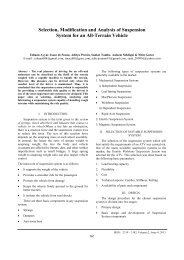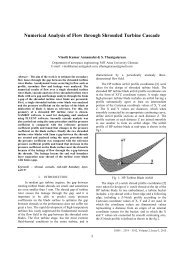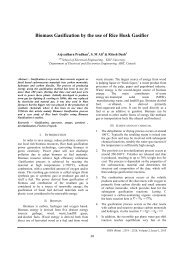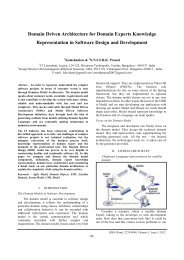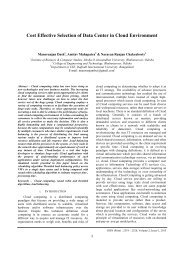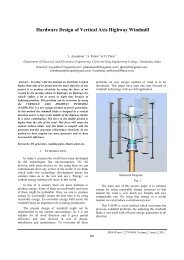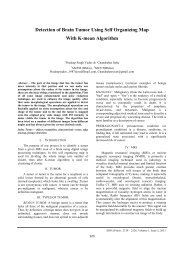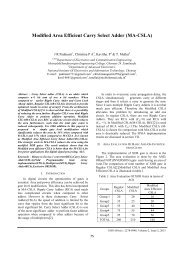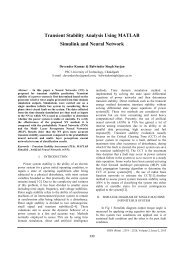Comparative Study of Techniques to Discover Frequent ... - IRD India
Comparative Study of Techniques to Discover Frequent ... - IRD India
Comparative Study of Techniques to Discover Frequent ... - IRD India
You also want an ePaper? Increase the reach of your titles
YUMPU automatically turns print PDFs into web optimized ePapers that Google loves.
International Journal on Advanced Computer Theory and Engineering (IJACTE)Fig.11. Scalability with threshold[8]Table 4. gives a comprehensive comparisonbetween the three algorithms, GSP, FAP-Growth andDFS algorithm. Fig.11 shows the scalability in GSP andFP-growth algorithms.FP-growth works in a divide-and-conquer way. Thefirst scan <strong>of</strong> the database derives a list <strong>of</strong> frequent itemsin which items are ordered by frequency descendingorder. According <strong>to</strong> the list, the database is representedas frequent-pattern tree, or FP-tree, which shows theassociation between items. The FP-tree starts withfrequent length-1 pattern (suffix pattern), constructingits conditional pattern base (a “subdatabase”, consistingthe prefix paths in the FP-tree containing the suffixpattern), then forming conditional FP-tree, andperforming mining recursively on this tree. It uses theleast frequent items as a suffix, <strong>of</strong>fering goodselectivity. Performance studies demonstrate that themethod substantially reduces search time.DFS is algorithms take a more incremental approach asit generates possible frequent sequences and uses adivide-and-conquer approach. This algorithm mainlymakes an attempt <strong>to</strong> lessen the search space.III. ACKNOWLEDGMENTI would like <strong>to</strong> thank Dr. J.W. Bakal Sir and MadhuMadam for facilitating all the necessary inputs, studymaterial and resources and guiding me with their richexperience. I would especially like <strong>to</strong> thank my parents,in-laws and my husband for their unconditional support.IV. REFERENCES[1] Theint Aye, “Web cleaning for mining <strong>of</strong> webusage patterns”, International Conference onComputer research and Development(ICCRD),pages 490-494, Vol. 2, May 2011[2] K. R. Suneetha, Dr. K. R. Krishnamoorthy,“Identifying User Behavior by Analyzing WebServer Access Log”, International Journal <strong>of</strong>Computer Science and NetworkSecurity(IJCSNS),pages 327-331, VOL.9 No.4,April 2009[3] Guangyuan Li Qin Xiao Qinbin Hu ChanganYuan, “An Efficient Algorithm for Mining<strong>Frequent</strong> Sequences in Dynamic Environment”,in Granular Computing, 2009, GRC '09. IEEEInternational Conference, pages: 329 – 333, Aug.2009[4] Jiawei Han · Hong Cheng · Dong Xin · XifengYan , “<strong>Frequent</strong> pattern mining: current statusand future directions” ,In Proceedings <strong>of</strong>International Conference on Data MiningKnowledge <strong>Discover</strong>y Journal(DATAMINE),pages 55-86, Vol. 15 No.1, March 2007[5] Murat Ali Bayir, Ismail H. Toroslu, AhmetCosar,” Performance Comparison <strong>of</strong> Pattern<strong>Discover</strong>y Methods on Web Log Data”,Computer Systems and Applications, IEEEInternational Conference, pages 445 – 451, April2006[6] Osmar R. Zaıane, Mohammad ElHajj, “PatternLattice Traversal by Selective Jumps”, in Proc.2005 Int'l Conf. on Knowledge <strong>Discover</strong>y andData Mining (ACM SIGKDD), pp 729-735,Chicago, August, 2005[7] Xidong Wang, Yiming Ouyang, Xuegang Hu,Yan Zhang, “<strong>Discover</strong>y <strong>of</strong> User <strong>Frequent</strong> AccessPatterns on Web Usage Mining”, ComputerSupported Cooperative Work in DesignProceedings 8 th IEEE International Conference,pages 765 – 769, Vol 1, November 2004[8] Jiawei Han, Jian Pei, Yiwen Yin ,Runying Mao,“Mining <strong>Frequent</strong> Patterns without CandidateGeneration: A <strong>Frequent</strong>-Pattern Tree Approach”,In Proceeding <strong>of</strong> International Conference onData Mining and Knowledge <strong>Discover</strong>y, 8, pp.53–87, 2004[9] Jian Pei, Jiawei Han, Behzad Mortazavi-Asl,Jianyong Wang, Helen Pin<strong>to</strong>, Qiming Chen,Umeshwar Dayal, Mei-Chun Hsu, “MiningSequential Patterns by Pattern-Growth: ThePrefixSpan Approach”, IEEE Transactions onKnowledge and Data Engineering, Vol. 16, No.11, November 2004[10] Jaideep Srivastava, Robert Cooleyz , MukundDeshpande, Pang-Ning Tan, “Web UsageMining: <strong>Discover</strong>y and Applications <strong>of</strong> UsagePatterns from Web Data”, In proceedings <strong>of</strong> the9th IEEE International conference on Tools with50ISSN (Print) : 2319 – 2526, Volume-2, Issue-3, 2013



